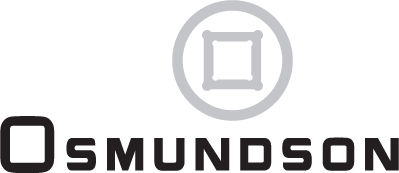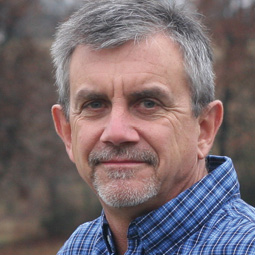Kinze Manufacturing started in 1965 when Jon Kinzenbaw, a 21-year old farm boy from Victor, Iowa, opened a welding shop. After struggling for almost a decade, Kinzenbaw would make his mark by developing products that enabled farmers to increase efficiency and cover more acres in less time during both planting and harvesting. His innovative planter design leapfrogged the rest of the industry and propelled the company to one of the largest, privately held agricultural equipment manufacturers in North America. Today, the company is led by his daughter, Susie Veatch, though Jon is regularly seen on the shop floor.
Origins in Repair & ‘Hopping Up’ Tractors
The company’s official start began in late 1965 when Kinzenbaw returned home after serving in the U.S. Army. “I talked about opening a hardware store,” he remembers. “But my real expertise was to look at something and fix it, so I changed the direction of the business to a welding and repair shop and bought an old building for $2,000.
“We started in October 1965 getting the building ready for a mid-December opening,” Kinzenbaw recalls, adding that he’d borrowed $3,500 for tools and equipment. “A fellow broke a loader frame and begged me to fix it because he needed it for chores the next morning. So, I did a $15 weld job on December 10, and that was the official start. We opened the doors, and never had a day we didn’t have something to do.”
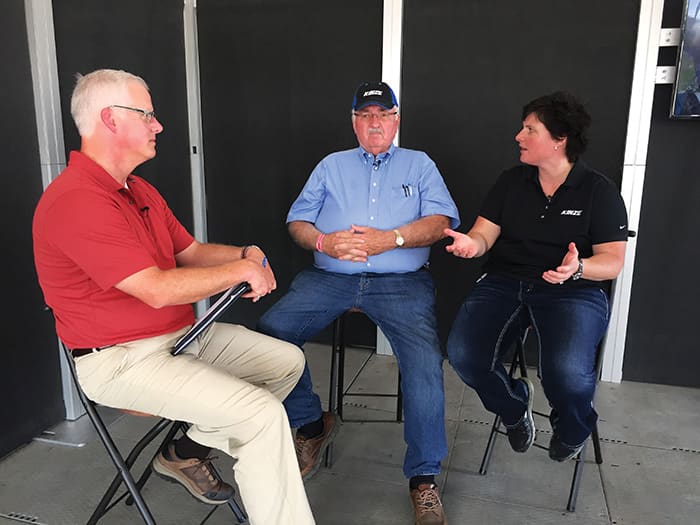
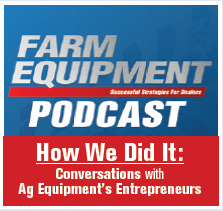
Listen to the award-winning story of Kinze Manufacturing in Jon Kinzenbaw and Susie Veatch’s own words and voice in the “How We Did It: Conversations with Ag Equipment’s Entrepreneurs” podcast series. Visit www.farm-equipment.com/kinzenbaw .
The first jobs were repairing farm implements, but that led to overhauling engines and truck and tractor service. Along the way, a niche was discovered in “repowering” John Deere tractors. “We were taking out the 130-horsepower engine and putting in a Detroit Diesel, which is about 300 horse,” Kinzenbaw says. “We could really make a plow move.”
At the same time, he’d also been doing work for a fertilizer dealer located across the road. They realized a higher horsepower tractor could lead to a quicker way to apply anhydrous ammonia, so he built a pair of large toolbars for that task. “They were 30-foot wide, and we started building the wagons to pull behind them. We had a 2,000-gallon wagon, which was unheard of then. With that kind of horsepower, we could double it. So, the anhydrous bar was kind of the first innovative product we built, followed by an adjustable width plow in ’71, which I licensed to DMI.”
In the fall of 1971, Kinzenbaw built a wagon for a local farmer to haul corn away from his combine, which spawned another idea. “We pioneered the grain cart concept, which had large, high, flotation tires and unloaded itself in under 3 minutes. It was the ‘go-between’ from the combine to the truck.” He recalls plenty of detractors telling him his concept wasn’t feasible. “But within 5 years, everybody seemed to need one.”
A milestone in the company’s development came when Kinzenbaw needed a shear and press brake and, because he couldn’t afford to buy them, made his own. “I built a 12-foot shear that would cut 0.25-inch plate and ended up finding out that it was tough enough to cut 0.5-inch plate. Then, when the business started taking off, I didn’t have time to build the press brake, so I bought a little 100-ton, 12-foot long Wisconsin Forcemaster; it cost me around $50,000, which I was able to borrow by that time. We’re still using it 40-plus years later.”
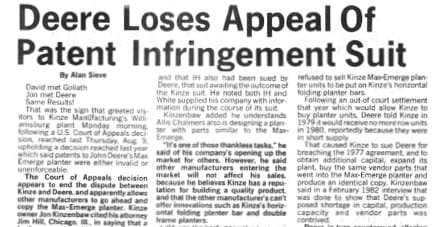
"The Rear-Fold Planter and the Battle that Ensued"
One of the most widely viewed pieces of content in Farm Equipment magazine history, this article is written in Jon’s own words about the “make or break” moment in the then-small company’s history. It includes details about his novel innovation, and also a “David vs. Goliath” type lawsuit with John Deere.
Even in the earliest days, Kinzenbaw wanted to attack inefficiency. “When first building grain carts, I’d build a frame, pull it outside and build another frame. Then, we’d bring them back in and put the axles under them, set the tubs and put the augers in.” Realizing that he was wasting a lot of unnecessary man-hours, Kinzenbaw took a cue from Henry Ford.
“I laid a piece of angle iron on the floor with the point up, made clips on it and then I’d bolt that to the floor. We had a steel roller on the hitch of the frame and, on the back, I had a pair of hard rubber tires like you would have on a wagon, for factory rollers. We started winching that through the plant and we’d hook one behind the other. The steel roller grounded that frame, so it would go past the guy welding who could do his job and then it’d go on. If he didn’t keep up in getting it down the line, the guys behind him would say, ‘Hurry up, get done.’ That put urgency in the process, and we doubled our production overnight.”

in 1965 after returning from the U.S. Army, Jon came up with a downpayment for a 80 x 40 old block building in Ladora, Iowa, in 1965 and opened for business (welding and repair) with no customers and $5000 in debt. At right is Williamsburg, Iowa, operations.
Every company longs for a product so far ahead that it leaves the competitors scrambling. For Kinzenbaw, that came with his folding planters. He refers to it as “disruptive innovation,” which is also the title of his 2015 autobiography. As planters grew larger to match farmers increasing acreage, Kinzenbaw heard friends complaining about time wasted dismantling and loading their planters onto drop-bed trailers. “If it got beyond an 8-row, they loaded it on a trailer and hauled it end-ways,” he remembers. Kinze’s rear folding planter toolbar was released in 1975, and to meet the fast-growing demand, Kinzenbaw purchased 10 acres of land and built a new manufacturing plant by in Williamsburg.
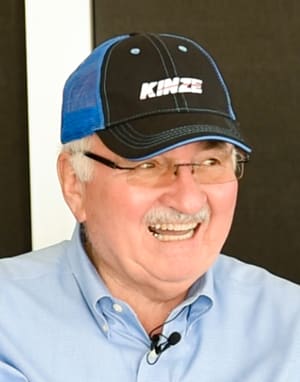
“We started in October 1965 getting the building ready for a mid-December opening. A fellow broke a loader frame and begged me to fix it because he needed it for chores the next morning. So, I did a $15 weld job on December 10, and that was the official start. We opened the doors, and never had a day we didn’t have something to do.” — Jon Kinzenbaw Founder, Kinze Manufacturing
In the early to mid-80s, the company chased another disruptive innovation and developed larger planters that could be lifted and rotated for transport, a concept which further cementing Kinze’s leadership in planting equipment. It also caught the attention of Deere & Co., which had been selling Kinze planting components and abruptly refused to fill orders. A “for the ages” lawsuit followed, which Kinzenbaw later won, and in the process he also developed his own row units and no longer relied on competitors for components.
In addition, the easy-to-transport planter excited dealers as the units could essentially be shipped field ready, without assembly. “We saved dealers a lot of money and then they'd also be eager to sell it because he wouldn’t need to spend 3 weeks’ work putting it together. A big planter that was 60 feet wide and had 47 rows on it, could be delivered on one load, all assembled. That was unheard of 20 years ago.”
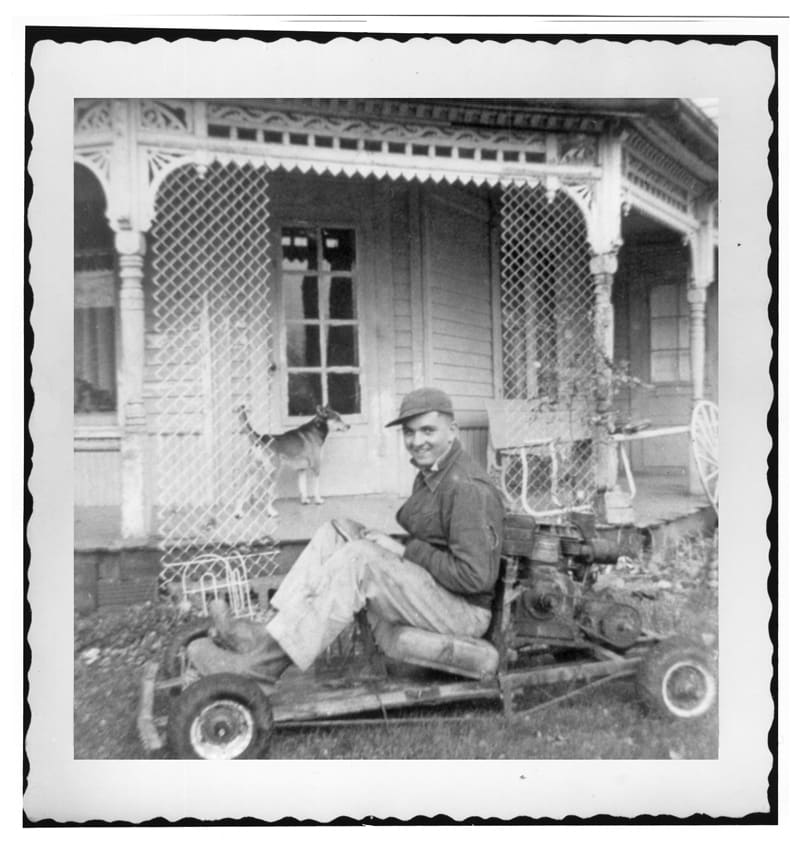
To see his friends on their own farms, Jon had to take matters into his own hands. After several iterations (including washing machine motors and bike wheels), he arrived at this self-designed go-cart in 1957.
Part of the uniqueness of the Kinze planter is the color. “I remember having a bunch of 6-row planters ready to paint,” Kinzenbaw reflects. “The year before, we painted them black and they were ‘chalky’ and looked terrible. So, I’m scratching my head trying to decide what to do. And one of the guys said, ‘Our wagon is accepted as blue, why don’t you paint them blue?’ And that quick, I said, ‘Hang them on the line, paint them blue.’
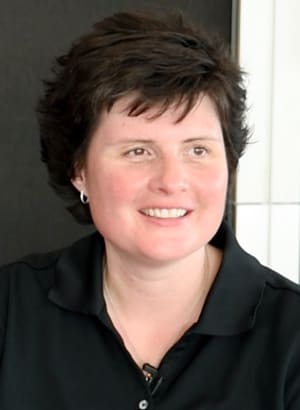
“Whatever trial you’re facing, you learn through that — how to go out and fight the battle and never give up. You need to figure out how to grow again and move forward. Those are the times that make you think, re-approach and try different things." — Susie Veatch, President, Kinze Manufacturing
“We’ve never looked back and, if you took that planter and painted it any other color, I think it’d look terrible. If there’s anything that I would say we have to sell besides our quality and name and is that blue color.”
The Long Hard Road
Kinzenbaw realized he was on to something when he started to write checks to the Internal Revenue Service, but success was a long time coming. “I started with $3,500 and 9 years later I was $100,000 in debt. In the 10th year, I finally made enough money to pay taxes. And the only reason I lasted 9 years, without making any money, was because the banker was 'locked in' with me.
“He was a good friend of my father and it never occurred to him to have Dad cosign the note. So, I borrowed on my signature and we kept going after that. There was a point in there when the banker was scratching his head thinking, ‘I don’t know how we’re going to get this money back’ — but he didn’t dare pull the plug or he’d lose it all; so he toughed it out.”
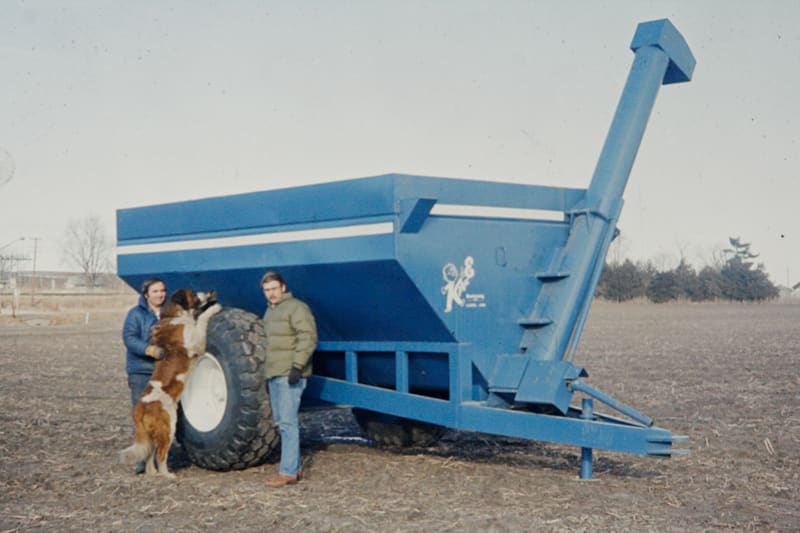
Kinze revolutionized harvesting with the first 2-wheeled grain cart in 1971. It would shake up the harvesting world again in 2011 with the first autonomous harvest system demonstration.
Another turning point came in 1974, when a well-known and successful friend agreed to co-sign Kinzenbaw’s bank note. “My banker said, ‘If he’s got confidence like that in you, we probably should, too. We can loan you that money and not get him involved.’ In those first 10 years I was always trying to figure out where I could borrow more, but I never had to go looking for money after that.”
Next Generation & Outside Experience
Susie Veatch, Kinzenbaw’s daughter, is president of Kinze today. At the age of 14, she began working at the plant. “I worked there through college — and eventually through pretty much every area in the organization. I always thought one day I might come back to the business, and Dad said, ‘If you’re going to come back, you need succeed somewhere else first.’ I appreciated that and I think our employees appreciated it, too.”
Veatch earned a business degree at Iowa State University, with internships along the way. She then began a career as a systems analyst with Caterpillar. She says the outside influences helped her understand the special nature of her parents’ company.
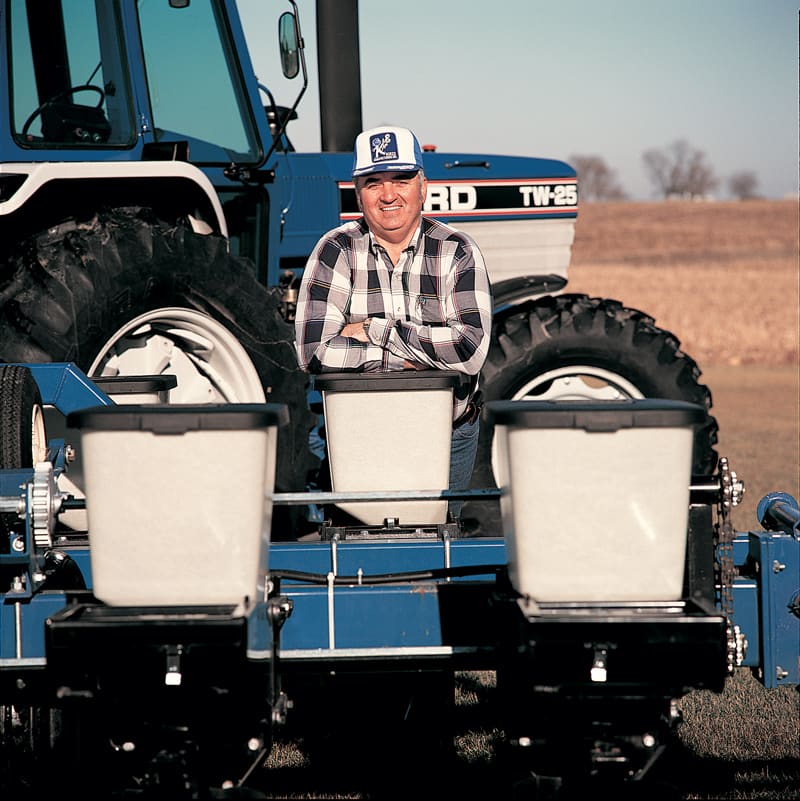
Jon Kinzenbaw in the 1980s, with the planters that would become his company’s core focus.
“When I came back in 2005 after working for Caterpillar, I appreciated even more the great people that we have in our business, from employees to dealers.” In addition, Veatch has also sought manufacturing people from outside of ag “where maybe techniques were ahead of ag but were principles that could be applied here.”
Kinzenbaw told his daughter at an early age that she could take over the company after he’d been there 50 years, a milestone that arrived in 2015. Veatch says her father jokes about her holding him to his word, but as president, she respects the past with a vision for the future. “Obviously, a lot of things haven’t changed that we’ll keep doing. I want to work alongside him and learn; to access wisdom and experience I couldn’t personally draw upon from those early years. The longer we work together, the more I’m comfortable with how Dad would want us to make decisions.”
Photo Gallery
See www.Farm-Equipment.com/KinzePhotos for some additional photos from the family’s historic collection.
As Kinzenbaw steps back even more from the day-to-day, it isn’t at all uncommon to find him in the plant, says Veatch. “We usually find him down with the engineers or out in the prototype shop. We’ve got a great team down there and a lot of expertise; he’s worked hard to mentor them. They know how he thinks when we design a product and carry that quality forward and into the future.”
Veatch has witnessed Kinze survive costly legal battles and struggle through downturns in the farm economy — and is experiencing the current one first-hand as its leader. She has strong feelings about adversity and the lessons they teach. “Whatever trial you’re facing, you learn through that — how to go out and fight the battle and never give up. You need to figure out how to grow again and move forward. Those are the times that make you think, re-approach and try different things.
“There are always challenges; whether it is people, a legal situation or whatever,” Veatch continues, “but we always come back to how fortunate we are to have the best workforce we could ask for — right here in the Midwest. A lot of people came from farms and understand how the product is used, and our dealers stand behind the product and promote it. It takes dealers to expand that footprint and support the end customer.
“I’ve traveled around the world a lot, especially in the last 10 years as we’re growing global business,” Veatch says, “and it doesn’t matter if I talk to a farmer in the Ukraine or in Williamsburg — the business of farming is similar. How they practice it may vary, but how they approach the idea of getting the seed in is pretty much the same. They say Kinze is a durable, easy to use product that gets their crop in the ground in a narrow window of time.”
Continuing the ‘Kinze Culture’
Veatch says the Kinze culture will continue to adhere to five principles: integrity, excellence, innovation, customer focus and mutual respect, which her parents helped define. “Those were the values that they came back with and we wrote a paragraph about each,” says Veatch. “We talk about them with every interview candidate, in all employee interactions, as well as in dealer meetings. Anyone interacting with Kinze should see those themes exhibited in their interactions.”
Veatch explains that integrity is emphasized first and foremost, as it is the one most at risk in today’s society. “We encounter that in our international operations, because some countries assume you’re going to do an under the table deal because that’s their culture. We make it very clear to our dealers globally; we’ll do everything above board and with integrity, because that’s what we’re all about.”
Despite the challenges and risk of international business, Veatch enjoys the purpose. “Not only are we building a great product that’s helping to feed the world, but we’re also providing a positive work environment for employees both here and at our factory in Lithuania. It’s exciting to see the growth and the changes in expanding around the world. We’ve put a lot of hard work and risk into that, but in the end, it’s very rewarding to see the results.”
Related Content
- The Rear-Fold Planter and the Battle that Ensued
- [Podcast] Conversations with Ag Equipment’s Entrepreneurs: Kinze's Jon Kinzenbaw and Susie Kinzenbaw Veatch
- Kinze’s Jon Kinzenbaw and Susie Kinzenbaw Veatch
- [Video] Inside Kinze’s Manufacturing Facility
- Video: Kinze Innovation Center
Farm Equipment‘s Ag Equipment Entrepreneurs series is brought to you by Osmundson.
From our made in America steel to our made in America process, we are proud to stamp Made in the USA on every part we manufacture. Osmundson blades use a boron based steel grade exclusively designed for quality, durability and impact resistance throughout the life of the part. Each raw element and steel chemistry is carefully measured, analyzed and calculated to ensure consistency 100% of the time. We use United States steel, which sets the standard for quality, performance and innovation that the rest of the world continues to follow. Our blades are put to the test in every field condition in every continent of the world. Our vast variety of sizes, shapes and thicknesses meet and exceed the specific needs of each end user. The Osmundson blade is committed to manufacturing with strength, pride and innovation. Visit www.osmundson.com.


